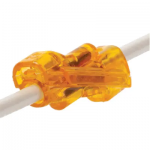Eddie_T
Member
- Occupation
- PE (retired)
I was troubleshooting a 3-way switch circuit for a friend. It was in a detached building classified as a garage but more of a man cave. The electrician that wired the building left wires too short to reach receptacle and switch screws so back stab connections were used. I was trying to determine if there was a switch problem, improper installation or a loose carrier wire. I pulled the disconnect in the sub panel, the lights went off and I was trying to get some slack in the wire when I got a shock. I could measure voltage on all three switch screws but didn't have a suitable wire to ground the circuit (I was afraid of frying a meter lead). I closed it up deciding to think it through. My guess is energy storage in the fluorescent circuitry but lack any experience there. I am going to try to make a coat hanger wire tool to release the stab connections to permit switch removal if necessary. If I do remove a switch I plan to add lengths of wire (maybe stranded) using wire nuts so that the switch screws can be used.



